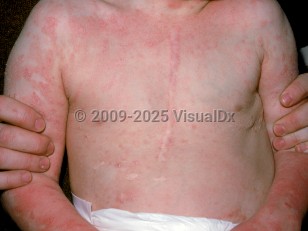CHIME syndrome in Child
Alerts and Notices
Important News & Links
Synopsis

CHIME syndrome is a rare neuroectodermal disorder characterized by bilateral colobomas of the eyes, congenital heart defects, severe ichthyosiform dermatosis beginning in the first month of life, moderate to severe intellectual disability, and ear abnormalities. This is thought to be caused by a disorder of glycosylation resulting from an abnormal PIGL gene. As the patient ages, characteristic facial features include brachycephaly; upslant of palpebral fissures; hypertelorism; flat midface and philtrum; anteverted nostrils; thin upper lip; widely spaced, irregularly shaped teeth; and excessive creasing around a wide mouth. The ears are often low set or cupped, with excessive desquamated cellular debris obstructing the ear canals. Less constant findings include hearing loss, cleft palate, pectus excavatum, and supernumerary nipples.
Seizures become common by age one and are difficult to treat. In adolescence, expect moderate to severe intellectual disability with autistic-like behaviors, seizures, and a chronic migratory, nonscarring skin eruption with pruritus. The discomfort related to the rash combined with intellectual disability is thought to contribute to behavioral issues including aggressive and self-harmful behaviors.
Cardiac manifestations include tetralogy of Fallot (TOF), transient global amnesia (TGA), pulmonic stenosis, and an enlarged aortic root.
Genital urinary malformations have also been described. This syndrome is considered extremely rare.
Seizures become common by age one and are difficult to treat. In adolescence, expect moderate to severe intellectual disability with autistic-like behaviors, seizures, and a chronic migratory, nonscarring skin eruption with pruritus. The discomfort related to the rash combined with intellectual disability is thought to contribute to behavioral issues including aggressive and self-harmful behaviors.
Cardiac manifestations include tetralogy of Fallot (TOF), transient global amnesia (TGA), pulmonic stenosis, and an enlarged aortic root.
Genital urinary malformations have also been described. This syndrome is considered extremely rare.
Codes
ICD10CM:
Q87.89 – Other specified congenital malformation syndromes, not elsewhere classified
SNOMEDCT:
720639008 – Coloboma, congenital heart disease, ichthyosiform dermatosis, intellectual disability ear anomaly syndrome
Q87.89 – Other specified congenital malformation syndromes, not elsewhere classified
SNOMEDCT:
720639008 – Coloboma, congenital heart disease, ichthyosiform dermatosis, intellectual disability ear anomaly syndrome
Look For
Subscription Required
Diagnostic Pearls
Subscription Required
Differential Diagnosis & Pitfalls

To perform a comparison, select diagnoses from the classic differential
Subscription Required
Best Tests
Subscription Required
Management Pearls
Subscription Required
Therapy
Subscription Required
References
Subscription Required
Last Reviewed:09/26/2021
Last Updated:11/09/2023
Last Updated:11/09/2023
CHIME syndrome in Child

